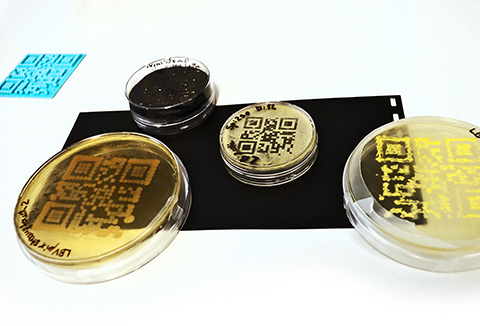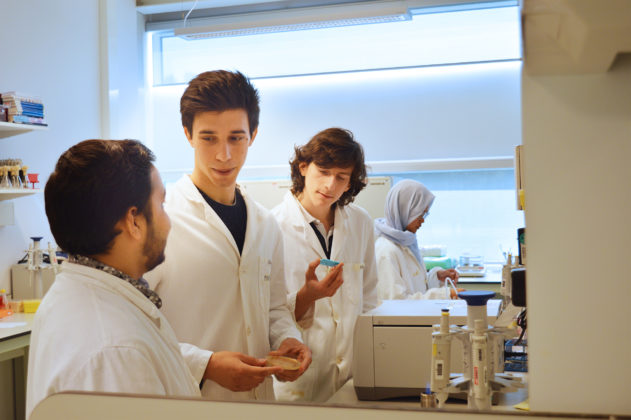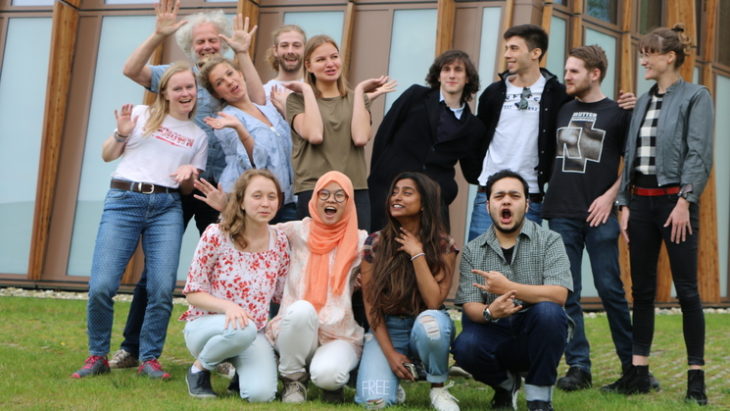
Genetically engineering bacteria
Protect your data; grow a code
You can find the black-and-white block codes everywhere: at the front door of the UKrant office, on wall texts at the Groninger Museum, or in your bank app. Even the Swapp bikes have QR codes that speedily direct you to a designated website.
They might be everywhere, but that doesn’t mean that using them is always safe.
Just last summer, police issued a warning about phishing scams using QR codes. Criminals may ask you to scan one, allegedly so they can make a payment. Before you know it, they’ve made off with all the money in your account.
A team of eleven student at the RUG wanted to find a way to make QR codes safe. So they set to work, toiling through the summer in their Linnaeusborg lab on the Zernike campus. ‘The basic idea is to add an extra layer of security when using QR codes’, explains Mariano Perez Chaher, an industrial engineering student from Groningen. ‘But we want to do that by slowing down the decryption instead of accelerating it.’
They decided to grow a QR code, using specially engineered bacteria.
Manipulating bacterial DNA
The project is Groningen’s entry for iGem, a worldwide competition for genetically engineered ‘machines’. Every year, thousands of students from all over the world travel to Boston to show how they manipulate bacterial DNA to do crazy things – like clean heavy metals from polluted water, make plastic out of recycled toilet paper, and generate energy from water.
In the case of the RUG team’s QR code project, ‘the encryption of the information in the code goes as fast as ever’, explains Mariano. ‘But we seed Vibrio natriegens in the shape of a QR code into a nutrient plate.’
Before you can decrypt the code and reveal the pattern, you have to make it grow. ‘But you have to know exactly how to do that’, says medical and pharmaceutical drug innovation student Nurul Wirusanti. ‘Different strains of our engineered bacteria grow under different conditions. We’ve created them to respond to light, to a certain temperature, or to the acidity of the environment.’
Under precise conditions, the QR code will appear after two or three hours. But make a mistake following the instructions, and you risk rendering it permanently illegible.
It sounds easy: grow some bacteria, get a code. But at times it seemed like the team would never get it right.
Geet has been experimenting with bacteria-infused ink
Because it turns out that even genetically engineered bacteria don’t like to grow in neat little squares that can be read by a QR scanner. ‘First we captured the bacteria in a gel, but found the pattern was still visible’, says Mariano. ‘So we decided to laser the bacteria in the places we didn’t want them to grow, but then it was impossible to transfer the pattern.’
‘Then we made stamps using a 3D printer’, says physics student Geet Kalsulkar, ‘but the bacteria grew outside of their squares, ruining the pattern.’
Tons of world-changing ideas
These last few weeks Geet has been experimenting with bacteria-infused ink from a specially adapted 3D printer. The preliminary results are good, but there are only six more weeks until the battle in Boston begins.
Molecular geneticists Oscar Kuipers and Jan Kok are not surprised that the project isn’t finished yet. ‘Students always think they have lots of time when they start in the weeks before summer’, says Kuipers, who supervised nine iGem teams from the start in 2008. ‘We warn them, of course, but they are really enthusiastic and come up with tons of crazy, world-changing ideas. But an idea has to be doable and everybody has to agree on it. So the brainstorming phase always takes too long.’
It took Mariano’s team almost six weeks before they had a viable and original idea, and they only have four months to complete the project. ‘It was really hard’, he says. ‘So many things have already been done!’
Geet, Mariano, Radu and Nurul in the iGem lab
And all for only 20 ECTS or less
Then they still had to do the work: engineer the bacteria in the lab, get the whole thing to work, present the data just right, and set up a cool presentation that will win over the jury. ‘They have to work really hard, way more hours than they get ECTS for’, acknowledges Kok, who supervised the last three Groningen iGem teams. ‘They easily put in 900 hours for only 20 ECTS or less. But it’s a unique chance. They get to show their organisational talent, learn lab skills. And it really looks good on their CV.’
World champion
Kuipers agrees. ‘It’s absolutely worth it. Especially for students who are not entirely satisfied by the standard courses. They get to do new things and can really excel. It’s worth it for us too: we get to spot potential new PhD students.’
Also, Groningen has done quite well in Boston. In 2012 the RUG team even became world champion with ‘Foodwarden’: a genetically engineered food sticker that turned purple when meat began to spoil. Other teams won gold for the ‘Best measurement’ (2018) or ‘Best Information Processing Project’ (2016).
That’s quite an achievement, considering the small size of the Groningen team. Students get no real help – just feedback and support – and there is hardly any funding for the project. ‘Other teams have way more support and funding from their universities’, Kuipers says. ‘When we became world champion in 2012, we got a little money the year after. But the following year, they told us it was not their job to support student projects.’
Persuading sponsors to support the team is hard, because they’ve never heard of iGem
That’s a little frustrating, Kuipers and Kok admit. The inspection committee for education is always enthusiastic about the iGem project. The faculty dean praised it as an outstanding form of education several times in his speeches. But praise isn’t money. So the team has to raise around 25,000 dollars each year just to participate. ‘The entry fee is 5,000 dollars’, Kok explains, ‘a plane ticket is easily 750 dollars per person, and they have to stay there a couple of nights. T-shirts have to be printed, posters made.’
Confident
Sometimes, crowdfunding falls short and team members can’t afford the ticket to Boston. Will that happen to Team Qroningen – as the students call themselves – this year? ‘We’ve had a slow start’, admits student Sophie Schretlen, who is responsible for getting sponsors. ‘But I do think we’ll get there. Things are picking up now.’
Sophie has found that most people have never heard of iGem, which makes it hard to persuade them to sponsor the team. But the students are confident their project deserves the support. Not because the world so desperately needs a QR code that has been grown from bacteria. ‘But we are showing how you can use bacteria to help protect data’, says Mariano. ‘It may not be the solution, but we can add a little bit of knowledge and show what is possible using genetic engineering.’
The Qroningen team consists of Mariano Perez Chaher, Geet Kalsulkar, Nurul Wirusanti, Radu Cimpean, Sophie Schretlen, Michelle Scharte, Sander de Weerd, Marc Mouthaan, Yashika Venkatesh, Daria Vedernikova, and Lieke van Iersel
Want to contribute? iGem Groningen has a crowdfunding page with more information. https://www.rugsteunt.nl/project/igem2019



